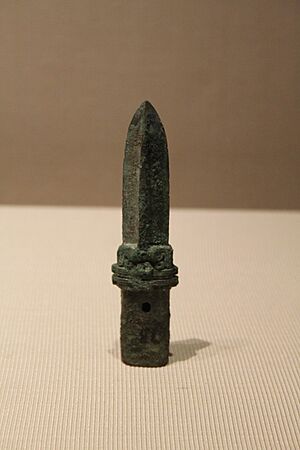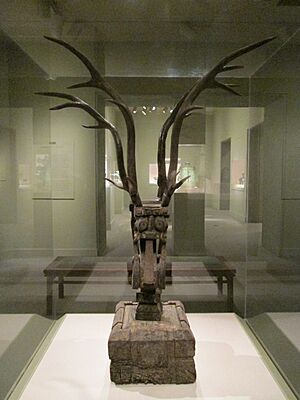Chu (state) facts for kids
Quick facts for kids
Chu
楚
*s-r̥aʔ |
|||||||
|---|---|---|---|---|---|---|---|
| c. 1030 BC – 223 BC | |||||||
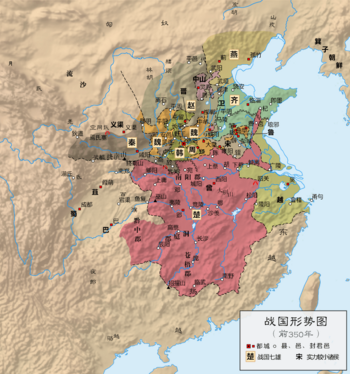
Chu (楚) c. 350 BC
|
|||||||
| Status | |||||||
| Capital |
|
||||||
| Religion |
|
||||||
| Government | Monarchy | ||||||
| Historical era | Zhou dynasty | ||||||
|
• Founded by Xiong Yi
|
c. 1030 BC | ||||||
|
• Xiong Tong proclaimed king
|
706 or 703 BC | ||||||
|
• Conquered by Qin
|
223 BC | ||||||
| Currency | Ancient Chinese coinage | ||||||
|
|||||||
| Chu | |||||||||||||||||||||||||||||||||||||||||||
|---|---|---|---|---|---|---|---|---|---|---|---|---|---|---|---|---|---|---|---|---|---|---|---|---|---|---|---|---|---|---|---|---|---|---|---|---|---|---|---|---|---|---|---|

"Chu" in seal script (top) and regular (bottom) Chinese characters
|
|||||||||||||||||||||||||||||||||||||||||||
| Chinese | 楚 | ||||||||||||||||||||||||||||||||||||||||||
|
|||||||||||||||||||||||||||||||||||||||||||
Chu (Chinese: 楚; pinyin: Chǔ; Wade–Giles: Ch'u) was an important ancient Chinese state that existed during the Zhou dynasty. It was located in the southern part of China. Chu was founded around 1030 BC and lasted until 223 BC.
The first ruler of Chu was King Wu of Chu in the early 8th century BC. Chu grew very powerful during the Spring and Autumn period and the Warring States period. However, it was eventually conquered by the Qin state in 223 BC, as Qin worked to unite all of China. Chu was also known as Jing (荊) or Jingchu (荊楚). Its territory covered much of what is now Hubei and Hunan provinces, plus parts of other areas like Chongqing and Henan.
For over 400 years, Chu's capital was Danyang. Later, the capital moved to Ying. The ruling family of Chu used the family name Mi (芈) and the clan name Xiong (熊).
Contents
History of Chu
How Chu Began
Ancient stories say that the ruling family of Chu came from the Yellow Emperor, a legendary leader in Chinese history. One of his descendants, Xiong Yi, was given the land of Chu by King Cheng of Zhou around 1030 BC. Xiong Yi was given the title of viscount, which was a noble rank. The first capital of Chu was set up in Danyang.
Early Years and Growth
Around 977 BC, King Zhao of Zhou died during a fight against Chu. After this, the Zhou dynasty stopped trying to expand south. This allowed Chu and other southern groups to become more independent. In 863 BC, a Chu viscount named Xiong Qu took over the state of E. Later, in 704 BC, the ruler Xiong Tong declared himself the first King of Chu, showing its growing power.
The Spring and Autumn Period
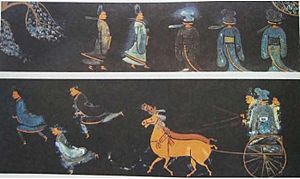
Under King Zhuang of Chu, Chu became very strong. He was even considered one of the "five Hegemons" of that time. Between 695 and 689 BC, Chu moved its capital from Danyang to Ying. Chu first grew by taking over smaller states nearby. Then, it expanded north towards the North China Plain. In 648 BC, the state of Huang became part of Chu.
Chu's power worried the northern states, especially Jin. They formed alliances to stop Chu. Chu lost a big battle at Chengpu in 632 BC. However, in 597 BC, Chu defeated Jin at the battle of Bi. This allowed Chu to expand its influence. Chu often used the state of Zheng to control the central plain. Jin tried to balance Chu's power by allying with states like Lu and Song. The fighting between Chu and Jin finally paused with a truce in 579 BC.
Later, Jin helped the state of Wu to fight against Chu. In 506 BC, Wu attacked Chu and took its capital, Ying. King Zhao of Chu had to run away. Chu then helped the state of Yue to fight Wu. Eventually, Yue defeated and took over Wu.
The Warring States Period
After its struggles with Wu ended, Chu grew again. It took over Chen in 479 BC and Cai in 447 BC. However, by the end of the 5th century BC, Chu's government became very corrupt. A lot of money was spent on the royal family, and many officials did little work. Chu's army was large but not very good.
In the late 390s BC, King Dao of Chu appointed Wu Qi as his chief minister. Wu Qi made big changes to make Chu stronger. He cut officials' salaries and removed those who were useless. His reforms made Chu very powerful until the late 4th century BC. Chu's army became successful again, defeating states like Wei and Yue. Yue was divided between Chu and Qi around 334 BC. Sadly, Wu Qi was killed at King Dao's funeral in 381 BC by angry officials.
Wu Qi once described the Chu people:
The Chu people are soft and weak. Their lands stretch far and wide, and the government cannot effectively administer the expanse. Their troops are weary and although their formations are well-ordered, they do not have the resources to maintain their positions for long. To defeat them, we must strike swiftly, unexpectedly and retreat quickly before they can counter-attack. This will create unease in their weary soldiers and reduce their fighting spirit. Thus, with persistence, their army can be defeated.
– Wu Qi, Wuzi
During the late Warring States period, Chu faced increasing pressure from the Qin state to its west. Qin had become very strong due to its strict laws and efficient government. In 241 BC, five major states, including Chu, formed an alliance to fight Qin. They attacked Qin at the Hangu Pass but were defeated. After this loss, Chu moved its capital further east to Shouchun to be safer from Qin.
As Qin expanded, Chu was forced to expand south and east. It took in local cultures as it grew. Lu was conquered by King Kaolie of Chu in 249 BC. However, Chu's power declined due to Qin's invasions.
The Fall of Chu
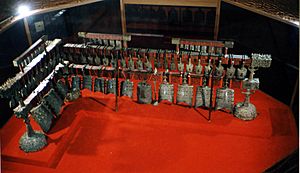
The state of Chu was eventually completely destroyed by the Qin dynasty. A Qin general named Sima Cuo believed that conquering the state of Shu would lead to conquering Chu. Shu was important because it had a lot of farmland and controlled the upper part of the Yangtze River, which flowed into Chu. In 316 BC, Qin conquered Shu and then expanded along the river. In 278 BC, the Qin general Bai Qi captured Chu's capital at Ying.
After Ying fell, the Chu government moved its capital several times before settling in Shouchun in 241 BC. By 225 BC, only four major kingdoms remained: Qin, Chu, Yan, and Qi. Chu had recovered enough to put up a strong fight. However, its government was still corrupt.
In 224 BC, the Qin leader Ying Zheng planned to invade Chu. General Wang Jian said they needed 600,000 soldiers, while another general, Li Xin, thought 200,000 would be enough. Ying Zheng sent Li Xin with a smaller army. The Chu army, led by Xiang Yan, surprised Li Xin's army and destroyed it.
Learning of this defeat, Ying Zheng put Wang Jian in charge of a massive 600,000-strong army. Wang Jian moved his army slowly and defended his positions. After a long wait, Xiang Yan's Chu army retreated, and Wang Jian launched a swift attack. The Qin forces chased the retreating Chu army, and Xiang Yan was either killed or took his own life.
In 223 BC, Qin launched another attack and captured Chu's capital, Shouchun. King Fuchu was captured, and the state of Chu was taken over by Qin. The next year, Qin also conquered the Wuyue region, which was around the mouth of the Yangtze River.
At their peak, Chu and Qin together had over a million soldiers. Letters from Qin soldiers show how long and difficult the campaign against Chu was.
After the Fall: Qin and Han Dynasties
Even after being conquered, the people of Chu disliked Qin's strict rules. They wanted to overthrow Qin and bring back their own state. A famous Chinese saying reflects this strong feeling: "Even if Chu has only three clans left, Qin will surely be destroyed by Chu."
After Qin Shi Huangdi declared himself the First Emperor, people from Chu led the first major rebellions against Qin. They especially hated being forced to work on projects like the Great Wall of China.
The Dazexiang Uprising started in 209 BC, led by a Chu peasant named Chen Sheng. He called himself "King of Rising Chu." This uprising was crushed, but it inspired many others. One leader, Jing Ju, also declared himself King of Chu. Later, Xiang Liang, a relative of Chu's old royal family, put Xiong Xin (a descendant of a former Chu king) on the throne as King Huai II.
After the Qin Empire fell in 206 BC, Xiang Liang's nephew, Xiang Yu, became the powerful "Hegemon-King of Western Chu." He later had King Huai II killed. Xiang Yu then fought against Liu Bang, another rebel leader, in a long war called the Chu–Han Contention. Liu Bang won this war, founding the Han dynasty. Xiang Yu took his own life.
Liu Bang created a less harsh government than Qin. He rewarded his allies with land, including the core Chu territories, which became the Kingdom of Chu under Liu Bang's brother. Over time, the culture of Chu mixed with the Han dynasty's traditions, helping to form what is now known as Chinese culture.
Chu Culture
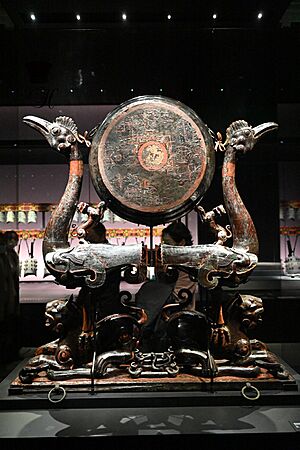
At first, Chu's culture was similar to other states in northern China. But as Chu expanded south and east, it took in ideas from the local Baiyue people. This created a unique mixed culture.
Over time, Chu culture became quite different from the northern states. It kept some old traditions and developed new ones. People in the central plains sometimes saw Chu as less "cultured." However, this view was often spread by later scholars who wanted to criticize certain ideas. Chu culture later became a key part of the Han dynasty's culture.
Early Chu tombs had bronze items, like other Zhou states. But later Chu burials, especially during the Warring States period, featured special items. These included colorful lacquerware, iron objects, and silk. Bronze items became less common. Chu art often showed animals and nature, like snakes, dragons, phoenixes, and tigers. Some experts think Chu might have had cultural links to the older Shang dynasty.
Chu people also worshipped gibbons and other animals they believed brought good luck. Chu culture was known for its shamans, who were spiritual leaders. The government supported Taoism and local shamanism. Chu people believed they were connected to Zhurong, the god of fire. Because of this, they practiced fire worship and used a lot of red color.
Chu's art, the Songs of Chu (a collection of poems), and ancient writings show strong influences from Taoism and local folk beliefs. Chu's focus on a spiritual and sometimes luxurious lifestyle, combined with its large size, may have led to its government becoming less efficient. This eventually contributed to its defeat by the very organized Qin state.
Archaeological finds show that Chu music was different from Zhou music. Chu used different musical groups and unique instruments. For example, the se (a type of zither) was more popular in Chu than in the northern states.
Chu often interacted with other southern peoples like the Ba and Yue. Many burial sites in Chu territory show a mix of Chu, Ba, and Yue styles. Chu artisans were famous for their colorful lacquer woodworks, especially using red and black. They were also skilled at silk-weaving, making light robes with flowing designs.
Chu used a special writing style called "Birds and Worms" script. This style decorated characters with images of animals, snakes, birds, and insects. This shows their connection to the natural world. Chu also made broad bronze swords, similar to those from the Wu and Yue states.
Chu developed a good system for transport using boats on rivers and wagons on land. Bronze tallies with gold inlay show how trade happened along the river systems connected to Chu's capital.
Government Structure
The Mo'ao (莫敖) and the Lingyin (令尹) were the highest government officials in Chu. The Sima was the commander of Chu's army. These three were the most powerful officials. Later, other officials like Zuoyin and Youyin were added to help the Lingyin. Similarly, the Sima had assistants called Zuosima and Yousima. Over time, the Lingyin and Sima became more powerful, while the Mo'ao's role became less important.
Many government positions in Chu were passed down through families, especially within certain branches of the royal family. For example, the Mo'ao was always chosen from the Qu (屈) clan.
Where Chu Was Located
The ancestors of Chu were said to come from the Jing Mountains in what is now Hubei province. Chu rulers often moved people from conquered states to these mountains to control them better. To the east of the Jing Mountains are the Tu mountains. In the northeast, the Dabie Mountains separated Chu from other regions.
The first capital of Chu, Danyang (丹陽), was in today's Zhijiang, Hubei. Ying (郢), a later capital, is now known as Jingzhou. Chu's northern border was protected by the Fangcheng mountain, where many castles were built.
The Yunmeng Ze was a huge lake in Chu's territory, located in the Jianghan Plain. It was crossed by the Yangtze River. The Shaoxi Pass was an important military outpost in Chu's western mountains. Any army coming from the west, especially from Qin, had to pass through Shaoxi.
States Conquered by Chu
Chu expanded its territory by taking over many smaller states over time. Here are some of them:
- 863 BC: E
- 704 BC: Quan
- 690 BC: Luo
- 688–680 BC: Shen
- 684–680 BC: Xi
- 678 BC: Deng
- 648 BC: Huang
- after 643 BC: Dao
- 623 BC: Jiang
- 622 BC: Liao
- 622 BC: Lù (六)
- after 622 BC: Ruo
- 611 BC: Yong
- 601 BC: Shuliao
- Sometime in the 6th century BC: Zhongli
- after 506 BC: Sui
- 574 BC: Shuyong
- 538 BC: Lai (賴國)
- 512 BC: Xu
- 479 BC: Chen
- 445 BC: Qi
- 447 BC: Cai
- 431 BC: Ju
- after 418 BC: Pi
- About 348 BC: Zou
- 334 BC: Yue
- 249 BC: Lu
Important Rulers of Chu
- Early rulers
- Jilian (季連): The first ancestor of the Chu ruling family.
- Yuxiong (鬻熊): A teacher of King Wen of Zhou.
- Xiong Li (熊麗): Son of Yuxiong, first to use the clan name Xiong.
- Xiong Yi (熊繹): The first ruler of Chu, given land by King Cheng of Zhou.
- Viscounts (early leaders)
- Xiong Ai (熊艾): Defeated and killed King Zhao of Zhou.
- Xiong Qu (熊渠): Gave his three sons the title of king, showing Chu's growing power.
- Xiong Tong (熊達): Declared himself the first King of Chu.
- Kings (most powerful rulers)
- King Wu of Chu (楚武王) (Xiong Da): Ruled 740–690 BC, declared himself the first king.
- King Wen of Chu (楚文王) (Xiong Zi): Ruled 689–677 BC, moved the capital to Ying.
- King Cheng of Chu (楚成王) (Xiong Yun): Ruled 671–626 BC, fought against the state of Jin.
- King Mu of Chu (楚穆王) (Xiong Shangchen): Ruled 625–614 BC.
- King Zhuang of Chu (楚莊王) (Xiong Lü): Ruled 613–591 BC, one of the most powerful kings, recognized as a Hegemon.
- King Gong of Chu (楚共王) (Xiong Shen): Ruled 590–560 BC.
- King Kang of Chu (楚康王) (Xiong Zhao): Ruled 559–545 BC.
- King Ping of Chu (楚平王) (Xiong Ju): Ruled 528–516 BC.
- King Zhao of Chu (楚昭王) (Xiong Zhen): Ruled 515–489 BC, had to flee when Wu captured the capital.
- King Hui of Chu (楚惠王) (Xiong Zhang): Ruled 488–432 BC, conquered Cai and Chen.
- King Dao of Chu (楚悼王) (Xiong Yi): Ruled 401–381 BC, appointed Wu Qi as chancellor to reform the government and army.
- King Xuan of Chu (楚宣王) (Xiong Liangfu): Ruled 369–340 BC.
- King Wei of Chu (楚威王) (Xiong Shang): Ruled 339–329 BC, divided the Yue state with Qi.
- King Huai of Chu (楚懷王) (Xiong Huai): Ruled 328–299 BC, was tricked and held hostage by Qin until his death.
- King Qingxiang of Chu (楚頃襄王) (Xiong Heng): Ruled 298–263 BC, saw Qin capture and sack Chu's capital.
- King Kaolie of Chu (楚考烈王) (Xiong Yuan): Ruled 262–238 BC, moved the capital to Shouchun.
- King You of Chu (楚幽王) (Xiong Han): Ruled 237–228 BC.
- Fuchu (楚王負芻) (Xiong Fuchu): Ruled 227–223 BC, captured by Qin troops.
- Lord Changping (昌平君): Ruled briefly in 223 BC, killed fighting Qin.
- Other important figures
- Chen Sheng (陳勝): A peasant who led an uprising against the Qin dynasty.
- Emperor Yi of Chu (楚義帝) (Xiong Xin): A descendant of the Chu royal family, put on the throne during the rebellions against Qin.
- Xiang Yu (項羽): A powerful general who fought against Qin and then against Liu Bang in the Chu–Han Contention.
- Liu Bang (劉邦): A former Chu citizen who became the founder of the Han dynasty.
Famous People from Chu
- Qu Yuan: A famous poet.
- Lord Chunshen: One of the Four Lords of the Warring States, a powerful figure.
- Xiang Yu: The "Hegemon-King of Western Chu" who fought against Qin and then against Liu Bang.
- Liu Bang: The founder of the Han dynasty, who was originally from the Chu region.
Chu in Astronomy
In ancient Chinese astronomy, Chu is represented by a star in the "Twelve States" group of stars. This group is part of the "Girl" lunar mansion. It is also shown by the star Epsilon Ophiuchi in the "Right Wall" group of stars.
See also
- Prime Minister of Chu
- Chu Silk Manuscript
- Chu Kingdom (Han dynasty)


